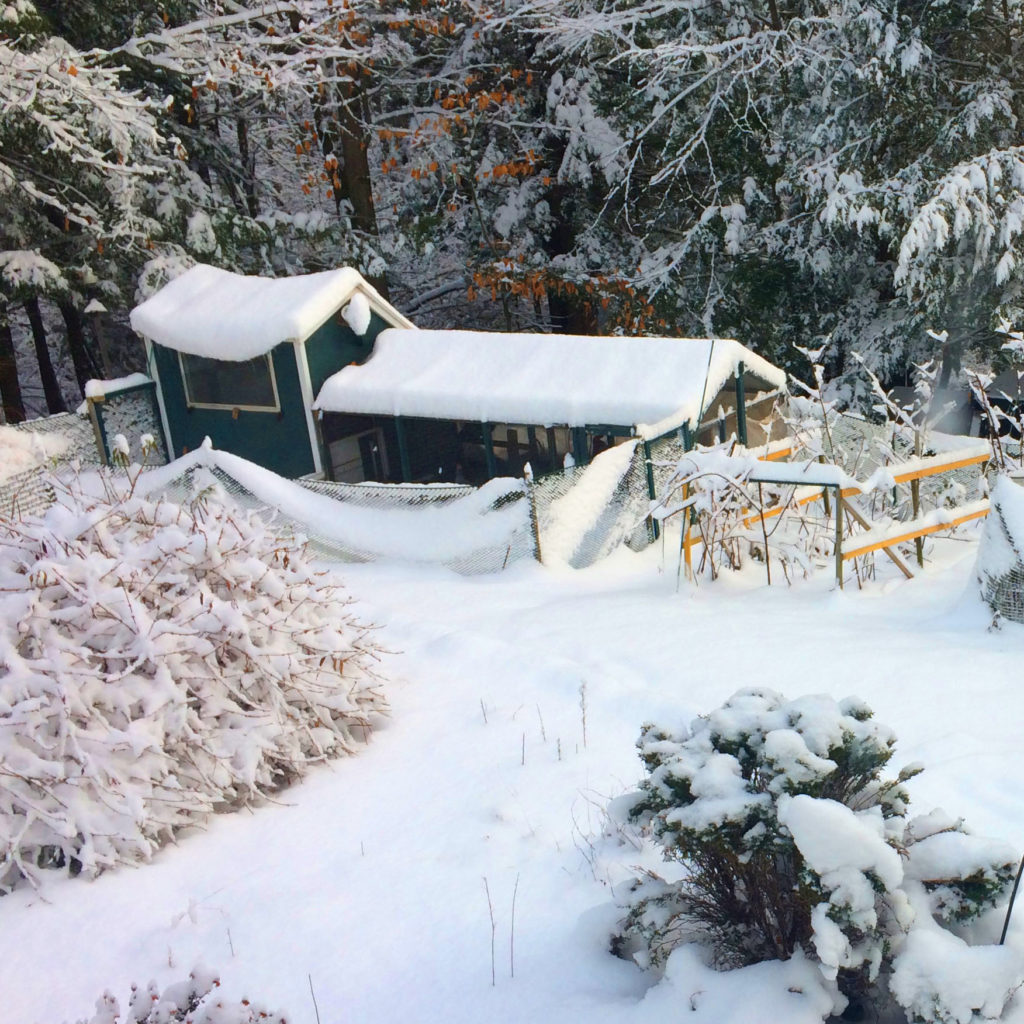
New Hampshire has gotten a long spell of subzero temperatures lately. We’ve had -10 at the house overnight. Daytime “highs” were in single digits. While we put on a thicker sweater and sit closer to the wood stove, what about our chickens out back in the coop? Do we provide them with some supplementary heat?
Actually, no. Many chicken breeds are quite hardy when it comes to the cold — often more so than handling the summer heat. After all, the wild turkeys, cardinals, chickadees and such, spend all winter outdoors without supplemental heat. Chickens can do it too.
As the weather gets colder, the chickens fluff up their feathers more. Instead of the classic chicken profile, standing tall with head held high, they resemble feathered footballs on one leg. They keep their head pulled in close and feathers fluffed out. I often see them standing on one foot. The other foot, they’ve pulled up inside their downy belly feathers to warm their toes against their bellies. At night, they tuck their heads under their wing. Sometimes they are so well tucked that they appear to be a seamless oval of nothing but feathers. This protects their combs and wattles from frostbite.
The rooster isn’t so lucky. While he, too, tucks his head in under his wing, his comb is just too tall. I can tell he’s going to lose some of his taller spikes to frostbite.
All in all, the chickens manage the subzero cold pretty well. Nonetheless, there are a few things a northern chicken owner needs to do to help them.
1. A dry, draft-free coop — While it seems counter-intuitive, a good winter coop has a fair amount of ventilation. The enemy is moisture. Chickens exhale a fair amount of water vapor as they sleep. They poop like crazy while they sleep and all that poop gives off moisture. If that moisture doesn’t have someplace else to go, it clings to the birds, especially fleshy parts like combs and feet. This increases the damage from frostbite.
Yet, for all the benefits of ventilation, the coop needs to protect your birds from windchill. The trick is to allow air in (and out), but slow it down. Think baffles and introducing air well below their roost bar and exhaust venting well above them.
A roost bar that is flat and wide (like a 2×4 laying horizontally) allows the birds to lay on their feet, fully covering their toes with down.
Protecting their run from snow helps too. This gives them a dry place to spend their day. Dry litter (leaves, straw, shavings, whatever) is much warmer to walk on in bare feet than snow. My chickens will tolerate walking on snow, but they don’t like it. I can’t blame them.
2. More Carbs –– While it’s generally a good idea not to overdo the high-carb treats like scratch grains, chickens in the winter need the extra carbs to generate body heat. Too much scratch in the summer will only make them put on fat. In the winter, they need those extra calories. I provide my birds with a “silage” made from lawn clippings. This gives them a daily dose of “greens” that they would otherwise not see until April. The greens are good for egg production too.
3. Liquid Water — Before we got the heated water bowl, part of the morning chicky-chores was to bring them a fresh bucket of water. The previous day’s bucket would be frozen solid. On very cold days, we would have to bring them a new bucket, as the morning bucket would freeze over a layer of ice too thick for them to peck through (which they will do, as long as they can). My birds are somewhat silly, too, in that they like to eat snow. Still, they need just as much water in the winter as they do in the summer. Liquid water.
4. Entertainment — Chickens get cabin fever, just like people do. Where, in warmer months, they had an acre to roam upon, snowfall restricts their world to under a hundred square feet. Chickens get bored. When they’re bored, they cause trouble as something to do. They’ll fight with each other more. Even if you don’t have overcrowding (and you shouldn’t) boredom can lead to trouble.
How to combat chicken boredom?
a. Chickens love to scratch. Have lots of loose litter in your coop and run. Toss treats (scratch, mealworm, kitchen scraps) in the litter and rake more litter over them. The birds will spend hours scratching everywhere to find a treat.
b. Chicken toys. Tie a small head of cabbage on a string and hang it in the run, about head-high to your birds. They’ll peck at for the rare greens, and play a sort of tether-ball game with themselves. A toy my birds like is a plastic spice bottle with a sunflower seed sized hole in the side. Filled with sunflower seeds, the bottle will dispense one if rolled around. Two or three of my birds have figured this out and will play soccer until they’ve emptied it.
c. Timed Treats. Instead of giving your birds all of the day’s kitchen scraps at once, parcel them out. This breaks up their day and heads off boredom.
If your birds have a secure, dry coop to sleep in, and some entertainment during the day, they’ll get through winter just fine without supplemental heat.
—
